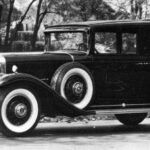By the early seventies large American cars with their powerful V8 engines were dominant. Every manufacturer had models similar to the Cadillac Eldorado which gobbled up 25 litres of fuel for every 100km travelled. War in the Middle East in 1973 saw Arab nations raise oil prices by 387 per cent, which, for a country like America that consumed so much, it was a nightmare.
Petrol station queues became the norm and two car owners ensured they had both an odd and even ending number licence plate so they could buy petrol any day of the week. More economical European cars, like BMWs and Mercedes, became the preferred choice as Americans traded in their ‘gas guzzlers’.
In answer to the US government’s call for more energy efficient cars General Motors first released the Cadillac Seville in 1975. It was designed to compete with Mercedes and Jaguars and was deliberately European in respect to size, ride, handling and, above all, economy. This model also saw the introduction of the first Cadillac diesel engine option as well as a fuel-economy computer.
The 8.0-litre V8s of the past were replaced with a 5.6-litre, 126kW V8 sourced from Oldsmobile which was mounted on a cushioned steel subframe to reduce harshness and noise vibration.
It was launched at a price below comparable Mercedes cars and was an immediate success. In its first year 44,500 Sevilles were sold compared with 45,000 Mercs.
The four-door sedan had a steel unitary body derived from the Chevy Nova with a zinc coating under the generous seven coats of paint. Its suspension comprised front coil springs with, at the rear, leaf springs with self-levelling ride. Although vented disc brakes were fitted to the front of the car, drum brakes were still used at the back.
Interior trim was a standard cloth finish with leather available in 10 shades as an option. A novel trip-computer offered 11 digital displays indicating such details as fuel, inside and outside temperature, engine speed, and estimated time of arrival.
Standard equipment included tilt steering wheel, a fuel-monitoring system, power seats and controlled-cycle windscreen wipers.










